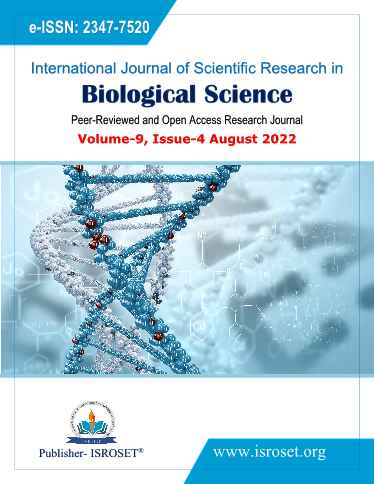Antimicrobial Activities and Phytochemical Screening of Five Nigerian Chewing Sticks
Keywords:
Phytochemical screening, Chewing sticks, antimicrobial screening, Oral microbesAbstract
Chewing sticks are important non-timber forest products widely used for dental cleaning in Nigeria. This work was intended to study the antimicrobial activities and phytochemical screening of some indigenous Nigerian chewing sticks which will serve as scientific support for the use of chewing sticks for oral hygiene in rural areas. Ethanol and aqueous extracts of Zanthoxylum zanthoxyloides, Massularia acuminata, Khaya ivorensis, Terminalia glaucescens and Azadirachta indica were obtained through soxhlet and maceration respectively. Qualitative and quantitative testing of bioactive compounds using standard procedures revealed the presence of tannins, reducing compounds, alkaloids, phenols, flavonoids, saponins and cardiac glycosides. Antimicrobial screening of the extracts was carried out on Staphylococcus aureus and Candida albicans which were isolated from mouth swabs. The ethanolic extract of K. ivorensis and A. indica had the highest antibacterial activity against Candida albicans and Staphylococcus aureus respectively. The aqueous extract of Massularia acuminata exerted an antimicrobial effect only on Candida albicans. The variation in the antimicrobial activities of the extracts could be attributed to the concentration of the various bioactive compounds present in the chewing sticks. This study has confirmed the effectiveness of these chewing sticks and toothbrushes against certain microorganisms.
References
K. Baruah, V.K. Thumpala, P. Khetami, Q. Baruah, R. V. Tiwari, H. Dixit, “A review of toothbrushes and toothbrushing methods,” International Journal of Pharmaceutical Science Invention, Vol.6, Issue.5, pp.29-38, 2017.
M. Abhary, A. Al-Hazmi, “Antibacterial activity of Miswak (Salvadora persica L.) extracts on oral hygiene,” Journal of Taibah University for Science, Vol.10, Issue.4, pp. 513-520, 2016.
O. Taiwo, H.X. Xu, S.F. Lee,” Antibacterial activities of extracts from Nigerian chewing sticks,” Phytother Res, Vol.13, Issue.8, pp. 675-9, 1999.
K.C. Ndukwe, I.N. Okeke, A. Lamikanra, S.K. A.O. Adesina, “Antibacterial activity of aqueous extract of selected chewing sticks, “Journal of Contemporary Dental Practice, Vol.6, pp.86-94, 2005.
A. Asase, T. Kokubun, R.J. Grayer, G. Kite, M.S.J. Simmonds, A.A. Oteng-Yeboah, et al, “Chemical constituents and antimicrobial activity of medicinal plants from Ghana: Cassia sieberiana, Haematostaphis barteri, Mitragyna inermis and Pseudocedrela kotschyi,” Phytotherapy Research, Vol.22, pp.1013-1016, 2008.
A. Sukkarwalla, S.M. Ali, P. Lundberg F. Tanwir, “Efficacy of miswak on oral pathogens,” Dent Res J (Isfahan), Vol.10, Issue.3, pp.314-20, 2013.
J.A. Akande, Y. Hayashi, “The potency of extract contents from selected tropical chewing sticks against Staphylococcus aureus and Staphylococcus auricularis,” World Journal of Microbiology and Biotechnology, Vol.14, pp.235-238, 1998.
P.M. Osamudiamen, O.O. Aiyelaagbe, S. Vaid, A.K. Saxena, “Comparative Evaluation of the Anti-cancer Activities of the Crude Extracts of Four Nigerian Chewing Sticks,” Journal of Biologically Active Products from Nature, Vol.8, Issue.3, pp.201-207, 2018.
F. B. Yakubu, J. Akoun, E. S. Anamayi, O. P. Duyilemi, “Mineral Composition Of Selected Tree Species Used For Chewing Stick In Southwestern Nigeria,” Journal of Agriculture, Forestry and the Social Sciences, Vol.6, Issue.1, pp.1-5, 2008.
A.M. Orire, G. E. Ebonyi, S.Y. Daniyan, “Effects of Replacement of Vegetable oil with Detoxified Jatropha curcas oil in the Diet of Clarias gariepinus (Burchell, 1822) fingerlings,” Nigerian Journal of Fisheries and Aquaculture, Vol.6, Issue.1, pp.7 –14, 2018.
O. Anyanwu, P. Eze, I. Nnaoma, K. Ngwoke, “Antimicrobial Properties of Jatropha curcas L. against Dental Pathogens,” Global Journal of Medical Research: J Dentistry & Otolaryngology, Vol.18, Issue.2, pp.1-7, 2018. DOI: 10.13140/RG.2.2.20593.74088.
S. Verma, N.S. Chauhan, “Indigenous medicinal plants knowledge of Kunihar forest division, district Solan,” Indian Journal of Traditional Knowledge, Vol.6, pp.494–497, 2007.
S.K. Jain, S. Srivastava, “Traditional use of some Indian plants among islanders of the Indian Ocean,” Indian Journal of Traditional Knowledge, Vol.4, pp.345–357, 2005.
N. Raaman, “Phytochemical techniques,” New India Publishing, pp.1-320, 2006
G. E. Trease, W. C. Evans, “A textbook of Pharmacognosy,” 11th edition Bailliere Tindall London. p. 530, 2013.
G. Barrow, R. Feltham, “Cowan and Steel`s Manual for the Identification of Medical Bacteria,” (3rd ed.). Cambridge: Cambridge University Press, 1993, doi:10.1017/CBO9780511527104
A. J. Vlietinck, L. Vanhoof, J. Totte, A. Lasure, B. D. Vanden, P. C. Rwangabo, J. Mvukiyumwami, “Screening of hundred Rwandese medicinal plants for antimicrobial and antiviral properties,” Journal of Ethnopharmacology, Vol.46, pp.31-47, 1995.
A. Mann, J. Yisa, L. A. Fadipe, J. A. Samuel, “The phytochemical and anti-termite activity of the stem bark and leaves of Zanthoxylum zanthoxyloides,” Journal of Chemical Society of Nigeria, Vol.38, Issue.2, pp.114-119, 2013.
A. Eliajh, I. Ola, “Phytochemical and antimicrobial screening of crude extracts from the root, stem bark, and leaves of Terminalia glaucescens,” African Journal of Pharmacy and Pharmacology, Vol.3, pp.217-221, 2009.
E. Essien, “Toxicity, hypoglycemic and antioxidant potentials of Massularia acuminata Stem,” Journal of Pharmacognosy and Phytochemistry, Vol.7, pp.1222-1226, 2018.
O.O. Adesanya, A.K. Asekunowo. O. T. Asekun, “Phytoconstituents analyses and antimicrobial activity of root extracts of Musa paradisiacal Linn. (Musaceae),” University of Lagos Journal of Basic Medical Sciences, Vol.5, Issue.9, pp.1-5,2017.
O.O. Ojo, A.O. Ajayi. I. I. Anibijuwon, “Antibacterial properties of extracts of some chewing sticks commonly used in southwestern Nigeria,” Journal of Pure and Applied Microbiology, Vol.1, Issue.1, pp.33-38, 2007.
E. S. Akpata, E. O. Akinrimisi, “Antibacterial activity of extracts from some African chewing sticks,” Journal of Oral Surgery, Vol.44, pp.712-722, 1987.
Downloads
Published
How to Cite
Issue
Section
License

This work is licensed under a Creative Commons Attribution 4.0 International License.
Authors contributing to this journal agree to publish their articles under the Creative Commons Attribution 4.0 International License, allowing third parties to share their work (copy, distribute, transmit) and to adapt it, under the condition that the authors are given credit and that in the event of reuse or distribution, the terms of this license are made clear.







